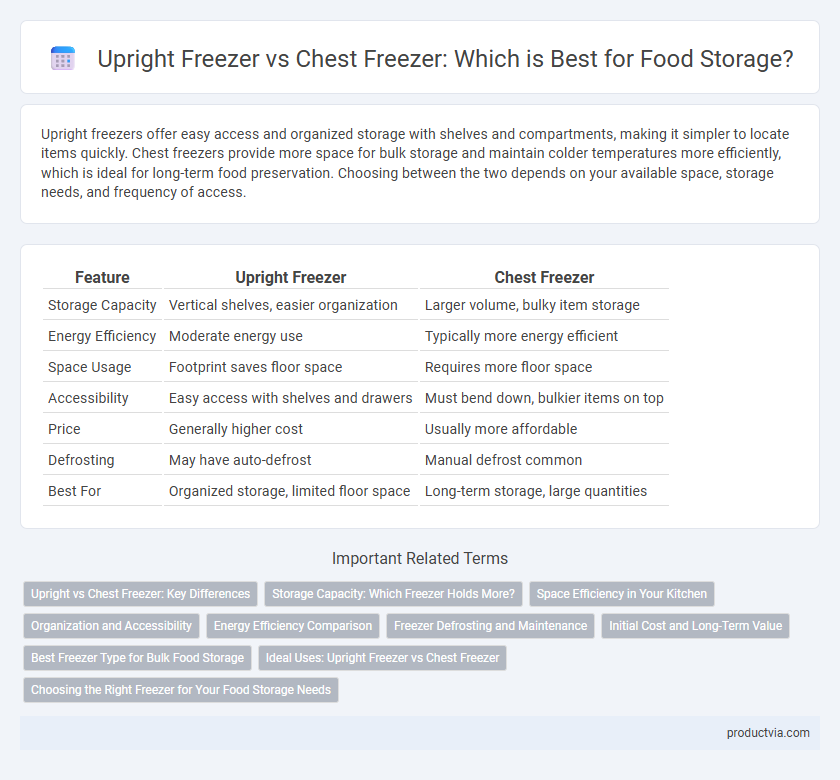Upright freezers offer easy access and organized storage with shelves and compartments, making it simpler to locate items quickly. Chest freezers provide more space for bulk storage and maintain colder temperatures more efficiently, which is ideal for long-term food preservation. Choosing between the two depends on your available space, storage needs, and frequency of access.
Table of Comparison
| Feature | Upright Freezer | Chest Freezer |
|---|---|---|
| Storage Capacity | Vertical shelves, easier organization | Larger volume, bulky item storage |
| Energy Efficiency | Moderate energy use | Typically more energy efficient |
| Space Usage | Footprint saves floor space | Requires more floor space |
| Accessibility | Easy access with shelves and drawers | Must bend down, bulkier items on top |
| Price | Generally higher cost | Usually more affordable |
| Defrosting | May have auto-defrost | Manual defrost common |
| Best For | Organized storage, limited floor space | Long-term storage, large quantities |
Upright vs Chest Freezer: Key Differences
Upright freezers offer better space efficiency with vertical shelving, making food organization and accessibility easier compared to chest freezers, which have a larger single compartment ideal for bulky items. Chest freezers typically maintain lower temperatures more consistently, providing superior energy efficiency and longer food preservation. Choosing between upright and chest freezers depends on the balance between convenience, storage capacity, and energy consumption for specific food storage needs.
Storage Capacity: Which Freezer Holds More?
Chest freezers typically offer greater storage capacity compared to upright freezers because their wide, uninterrupted space allows for bulkier items and better organization without shelves or compartments limiting the area. Upright freezers usually have a smaller total volume but provide easier access due to vertical shelves and door bins. For maximizing food storage space, chest freezers generally hold more frozen goods per cubic foot.
Space Efficiency in Your Kitchen
Upright freezers offer vertical storage that maximizes floor space, making them ideal for smaller kitchens or tight spaces. Chest freezers provide more overall capacity with wider shelves and bins but require more floor space, which may limit kitchen movement. Choosing between the two depends on balancing available kitchen space and the volume of food storage needed.
Organization and Accessibility
Upright freezers offer superior organization with multiple shelves and door bins, making it easier to categorize and access food items without digging through layers. Chest freezers typically provide more storage capacity but require stacking, which can limit accessibility and demand more time to locate specific items. Choosing between the two depends on whether ease of access or maximum storage volume is prioritized for efficient food management.
Energy Efficiency Comparison
Upright freezers typically consume more energy due to less effective insulation and frequent door openings, causing temperature fluctuations. Chest freezers generally offer superior energy efficiency with thicker insulation and a tighter seal that maintains consistent cold temperatures. Studies indicate chest freezers can use up to 20-30% less electricity than upright models, making them a cost-effective choice for long-term food storage.
Freezer Defrosting and Maintenance
Upright freezers require more frequent defrosting due to faster ice buildup on vertical surfaces, while chest freezers accumulate frost more slowly, reducing the defrosting frequency. Chest freezers often feature manual defrosting and need periodic removal of ice to maintain efficiency, whereas many upright models come with automatic or frost-free defrost systems that minimize maintenance efforts. Proper maintenance, including regular defrosting and cleaning of door seals, ensures optimal food preservation and energy efficiency for both freezer types.
Initial Cost and Long-Term Value
Upright freezers generally have a higher initial cost compared to chest freezers due to their design and ease of access. Chest freezers offer better long-term value by consuming less energy and maintaining a more consistent temperature, which helps preserve food for extended periods. Choosing a chest freezer can result in lower electricity bills and reduced food waste over time.
Best Freezer Type for Bulk Food Storage
Chest freezers offer superior energy efficiency and better temperature retention for bulk food storage compared to upright freezers. Their spacious, wide compartments allow easy stacking of large quantities of food without compromising cold air circulation. Upright freezers provide better organization with shelves and door bins but generally consume more power, making chest freezers the preferred choice for long-term, bulk storage.
Ideal Uses: Upright Freezer vs Chest Freezer
Upright freezers excel in organizing frequently accessed items due to their vertical shelves and door compartments, making them ideal for smaller kitchens and everyday meal prepping. Chest freezers offer superior energy efficiency and larger storage capacity, perfect for bulk storage of seasonal produce, meat, and long-term food preservation. Choosing between them depends on usage patterns: upright freezers suit quick access and limited spaces, while chest freezers accommodate extensive stockpiling and lowest energy consumption.
Choosing the Right Freezer for Your Food Storage Needs
Upright freezers offer easy access and organized storage with multiple shelves, making them ideal for frequent use and smaller spaces. Chest freezers provide superior energy efficiency and maintain lower temperatures, which is perfect for long-term storage of large bulk items. Choosing the right freezer depends on your available space, usage frequency, and the types of food you plan to store.
Upright freezer vs Chest freezer for food storage Infographic

 productvia.com
productvia.com